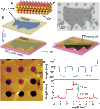Elastic properties of 2D Ti3C2T x MXene monolayers and bilayers
- PMID: 29922719
- PMCID: PMC6003751
- DOI: 10.1126/sciadv.aat0491
Elastic properties of 2D Ti3C2T x MXene monolayers and bilayers
Abstract
Two-dimensional (2D) transition metal carbides and nitrides, known as MXenes, are a large class of materials that are finding numerous applications ranging from energy storage and electromagnetic interference shielding to water purification and antibacterial coatings. Yet, despite the fact that more than 20 different MXenes have been synthesized, the mechanical properties of a MXene monolayer have not been experimentally studied. We measured the elastic properties of monolayers and bilayers of the most important MXene material to date, Ti3C2T x (T x stands for surface termination). We developed a method for preparing well-strained membranes of Ti3C2T x monolayers and bilayers, and performed their nanoindentation with the tip of an atomic force microscope to record the force-displacement curves. The effective Young's modulus of a single layer of Ti3C2T x was found to be 0.33 ± 0.03 TPa, which is the highest among the mean values reported in nanoindentation experiments for other solution-processed 2D materials, including graphene oxide. This work opens a pathway for investigating the mechanical properties of monolayers and bilayers of other MXenes and extends the already broad range of MXenes' applications to structural composites, protective coatings, nanoresonators, and membranes that require materials with exceptional mechanical properties.
Figures



Similar articles
-
Elastic properties and tensile strength of 2D Ti3C2Tx MXene monolayers.Nat Commun. 2024 Feb 21;15(1):1566. doi: 10.1038/s41467-024-45657-6. Nat Commun. 2024. PMID: 38378699 Free PMC article.
-
3D printing lamellar Ti3C2T x MXene/graphene hybrid aerogels for enhanced electromagnetic interference shielding performance.RSC Adv. 2022 Sep 1;12(38):24980-24987. doi: 10.1039/d2ra02951k. eCollection 2022 Aug 30. RSC Adv. 2022. PMID: 36199879 Free PMC article.
-
Negative photoresponse in Ti3C2T x MXene monolayers.Nanophotonics. 2022 Jul 14;11(17):3953-3960. doi: 10.1515/nanoph-2022-0182. eCollection 2022 Sep. Nanophotonics. 2022. PMID: 39635166 Free PMC article.
-
Electronic and Optical Properties of 2D Transition Metal Carbides and Nitrides (MXenes).Adv Mater. 2018 Dec;30(52):e1804779. doi: 10.1002/adma.201804779. Epub 2018 Nov 19. Adv Mater. 2018. PMID: 30450752 Review.
-
2D transition metal carbides (MXenes) in metal and ceramic matrix composites.Nano Converg. 2021 Jun 2;8(1):16. doi: 10.1186/s40580-021-00266-7. Nano Converg. 2021. PMID: 34076789 Free PMC article. Review.
Cited by
-
Advances in Smart Photovoltaic Textiles.ACS Nano. 2024 Feb 6;18(5):3871-3915. doi: 10.1021/acsnano.3c10033. Epub 2024 Jan 23. ACS Nano. 2024. PMID: 38261716 Free PMC article. Review.
-
Scalable ultrastrong MXene films with superior osteogenesis.Nature. 2024 Oct;634(8036):1103-1110. doi: 10.1038/s41586-024-08067-8. Epub 2024 Oct 30. Nature. 2024. PMID: 39478209
-
Towards hospital-on-chip supported by 2D MXenes-based 5th generation intelligent biosensors.Biosens Bioelectron. 2023 Jan 15;220:114847. doi: 10.1016/j.bios.2022.114847. Epub 2022 Oct 27. Biosens Bioelectron. 2023. PMID: 36335709 Free PMC article. Review.
-
Molecular Dynamics Study of Bending Deformation of Mo2Ti2C3 and Ti4C3 (MXenes) Nanoribbons.Molecules. 2024 Oct 1;29(19):4668. doi: 10.3390/molecules29194668. Molecules. 2024. PMID: 39407597 Free PMC article.
-
MXenes and MXene-supported nanocomposites: a novel materials for aqueous environmental remediation.RSC Adv. 2022 Dec 6;12(53):34766-34789. doi: 10.1039/d2ra05530a. eCollection 2022 Nov 29. RSC Adv. 2022. PMID: 36540274 Free PMC article. Review.
References
-
- Lee C., Wei X., Kysar J. W., Hone J., Measurement of the elastic properties and intrinsic strength of monolayer graphene. Science 321, 385–388 (2008). - PubMed
-
- Novoselov K. S., Fal’ko V. I., Colombo L., Gellert P. R., Schwab M. G., Kim K., A roadmap for graphene. Nature 490, 192–200 (2012). - PubMed
-
- Ferrari A. C., Bonaccorso F., Fal’ko V., Novoselov K. S., Roche S., Bøggild P., Borini S., Koppens F. H. L., Palermo V., Pugno N., Garrido J. A., Sordan R., Bianco A., Ballerini L., Prato M., Lidorikis E., Kivioja J., Marinelli C., Ryhänen T., Morpurgo A., Coleman J. N., Nicolosi V., Colombo L., Fert A., Garcia-Hernandez M., Bachtold A., Schneider G. F., Guinea F., Dekker C., Barbone M., Sun Z., Galiotis C., Grigorenko A. N., Konstantatos G., Kis A., Katsnelson M., Vandersypen L., Loiseau A., Morandi V., Neumaier D., Treossi E., Pellegrini V., Polini M., Tredicucci A., Williams G. M., Hee Hong B., Ahn J.-H., Min Kim J., Zirath H., van Wees B. J., van der Zant H., Occhipinti L., Di Matteo A., Kinloch I. A., Seyller T., Quesnel E., Feng X., Teo K., Rupesinghe N., Hakonen P., Neil S. R. T., Tannock Q., Löfwander T., Kinaret J., Science and technology roadmap for graphene, related two-dimensional crystals, and hybrid systems. Nanoscale 7, 4598–4810 (2015). - PubMed
-
- Hu K., Kulkarni D. D., Choi I., Tsukruk V. V., Graphene-polymer nanocomposites for structural and functional applications. Prog. Polym. Sci. 39, 1934–1972 (2014).
-
- Bertolazzi S., Brivio J., Kis A., Stretching and breaking of ultrathin MoS2. ACS Nano 5, 9703–9709 (2011). - PubMed
Publication types
LinkOut - more resources
Full Text Sources
Other Literature Sources

